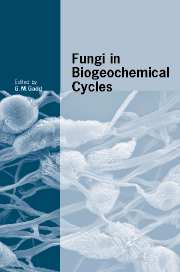Book contents
- Frontmatter
- Contents
- List of Contributors
- Preface
- 1 Geomicrobiology: relative roles of bacteria and fungi as geomicrobial agents
- 2 Integrated nutrient cycles in boreal forest ecosystems – the role of mycorrhizal fungi
- 3 Fungal roles in transport processes in soils
- 4 Water dynamics of mycorrhizas in arid soils
- 5 Integrating ectomycorrhizal fungi into quantitative frameworks of forest carbon and nitrogen cycling
- 6 Role of arbuscular mycorrhizal fungi in carbon and nutrient cycling in grassland
- 7 The role of wood decay fungi in the carbon and nitrogen dynamics of the forest floor
- 8 Relative roles of bacteria and fungi in polycyclic aromatic hydrocarbon biodegradation and bioremediation of contaminated soils
- 9 Biodegradation and biodeterioration of man-made polymeric materials
- 10 Fungal dissolution and transformation of minerals: significance for nutrient and metal mobility
- 11 Fungal activities in subaerial rock-inhabiting microbial communities
- 12 The oxalate–carbonate pathway in soil carbon storage: the role of fungi and oxalotrophic bacteria
- 13 Mineral tunnelling by fungi
- 14 Mineral dissolution by ectomycorrhizal fungi
- 15 Lichen biogeochemistry
- 16 Fungi in subterranean environments
- 17 The role of fungi in carbon and nitrogen cycles in freshwater ecosystems
- 18 Biogeochemical roles of fungi in marine and estuarine habitats
- Index
- References
9 - Biodegradation and biodeterioration of man-made polymeric materials
Published online by Cambridge University Press: 10 December 2009
- Frontmatter
- Contents
- List of Contributors
- Preface
- 1 Geomicrobiology: relative roles of bacteria and fungi as geomicrobial agents
- 2 Integrated nutrient cycles in boreal forest ecosystems – the role of mycorrhizal fungi
- 3 Fungal roles in transport processes in soils
- 4 Water dynamics of mycorrhizas in arid soils
- 5 Integrating ectomycorrhizal fungi into quantitative frameworks of forest carbon and nitrogen cycling
- 6 Role of arbuscular mycorrhizal fungi in carbon and nutrient cycling in grassland
- 7 The role of wood decay fungi in the carbon and nitrogen dynamics of the forest floor
- 8 Relative roles of bacteria and fungi in polycyclic aromatic hydrocarbon biodegradation and bioremediation of contaminated soils
- 9 Biodegradation and biodeterioration of man-made polymeric materials
- 10 Fungal dissolution and transformation of minerals: significance for nutrient and metal mobility
- 11 Fungal activities in subaerial rock-inhabiting microbial communities
- 12 The oxalate–carbonate pathway in soil carbon storage: the role of fungi and oxalotrophic bacteria
- 13 Mineral tunnelling by fungi
- 14 Mineral dissolution by ectomycorrhizal fungi
- 15 Lichen biogeochemistry
- 16 Fungi in subterranean environments
- 17 The role of fungi in carbon and nitrogen cycles in freshwater ecosystems
- 18 Biogeochemical roles of fungi in marine and estuarine habitats
- Index
- References
Summary
Introduction
Man-made polymeric materials are ubiquitous in our everyday lives and have an enormous range of applications from man-made textiles to plastics, coatings, paints and additives. As a consequence, a vast array of man-made polymers accumulates in the environment and landfill waste sites where they cause considerable water and land pollution problems. Over the last few decades, plastics and plasticizers in particular, due to their wide production and distribution, have led to a large increased environmental burden (Bouwer, 1992). According to recent estimates, the annual production of plastics in the world exceeds more than 140 million tonnes per year (Shimao, 2001). Plastics possess a number of key characteristics including weight, inertness, flexibility and low production costs that make them widespread in many areas of human life. However, it is their inertness and durability, valuable during their use, that becomes a particular problem later during their disposal. Contrary to other synthetic chemicals and pesticides, synthetic polymers do not generally possess particular toxicological problems, unless supplied with protective agents such as biocides (Bentivegna & Piatkowski, 1998) or particular plasticizers, such as phthalates (Staples et al., 1997; Zeng et al., 2002). Plastics however contribute greatly to the amount of municipal solid waste (Palmisano & Pettigrew, 1992) and are an increasing problem due to improper disposal (Alexander, 1994). The UK alone consumed 4.7 million tonnes of plastics in 2002 with most of the material being used in packaging and the building/construction industries (Fig. 9.1).
- Type
- Chapter
- Information
- Fungi in Biogeochemical Cycles , pp. 212 - 235Publisher: Cambridge University PressPrint publication year: 2006
References
- 13
- Cited by

